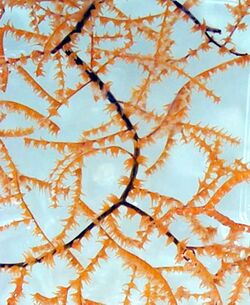| Display title | Biology:Black coral |
| Default sort key | Black Coral |
| Page length (in bytes) | 34,418 |
| Namespace ID | 3026 |
| Namespace | Biology |
| Page ID | 713914 |
| Page content language | en - English |
| Page content model | wikitext |
| Indexing by robots | Allowed |
| Number of redirects to this page | 1 |
| Counted as a content page | Yes |
| Page image |  |
| HandWiki item ID | None |
| Edit | Allow all users (infinite) |
| Move | Allow all users (infinite) |
| Page creator | imported>Scavis |
| Date of page creation | 16:56, 11 February 2024 |
| Latest editor | imported>Scavis |
| Date of latest edit | 16:56, 11 February 2024 |
| Total number of edits | 1 |
| Recent number of edits (within past 90 days) | 0 |
| Recent number of distinct authors | 0 |
Description | Content |
Article description: (description)
This attribute controls the content of the description and og:description elements. | Antipatharians, also known as black corals or thorn corals, are an order of soft deep-water corals. These corals can be recognized by their jet-black or dark brown chitin skeletons, which are surrounded by their colored polyps (part of coral that is alive). Antipatharians are a cosmopolitan order, existing... |
